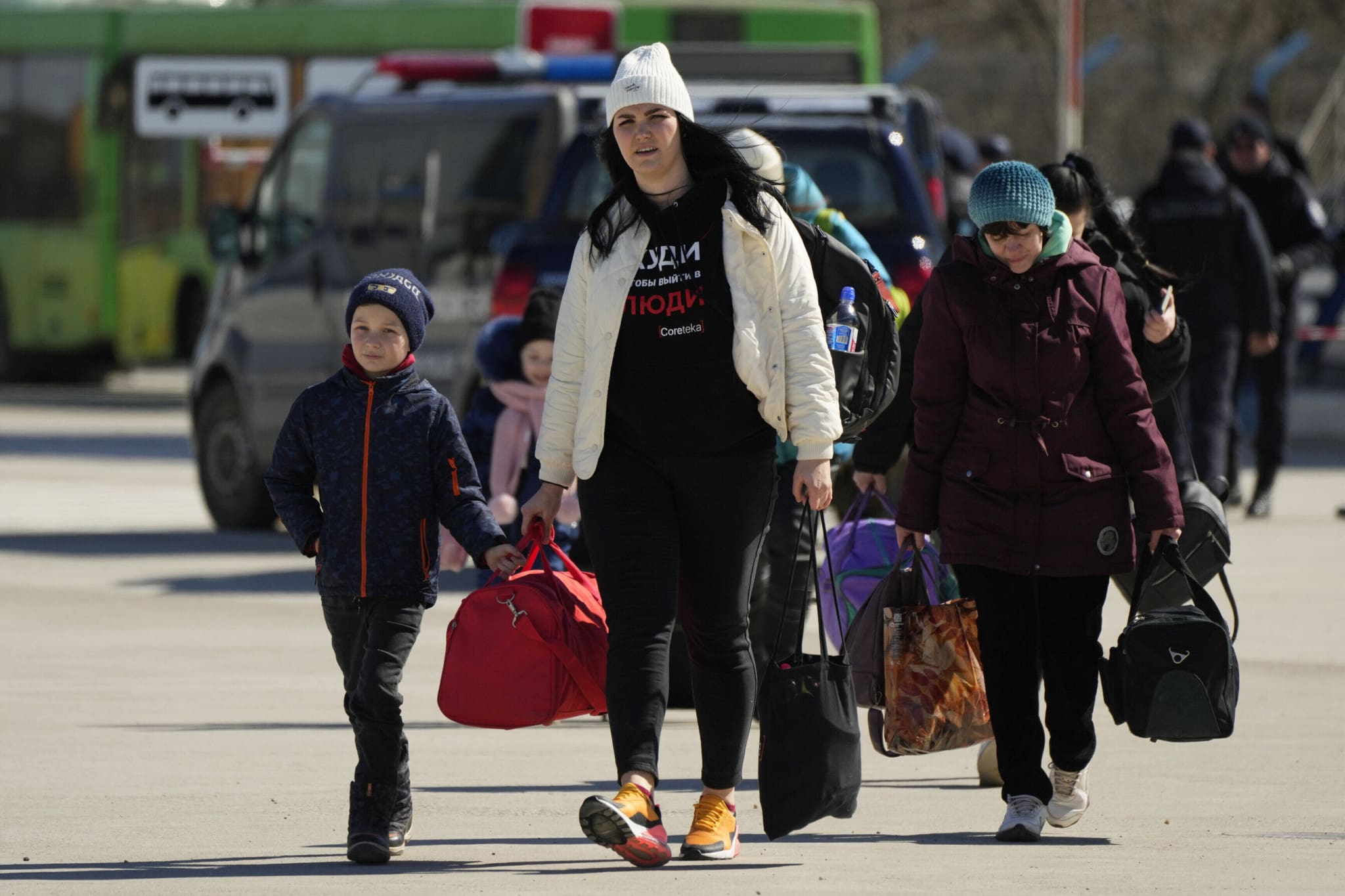As soon as Ukrainians began fleeing their country en masse, the warm reception they have received has garnered praise but also claims of racism.
A change in the rhetoric has appeared in recent days, said Smaïn Laacher, a sociologist and specialist on the forced displacement of populations in the European area.
“There is a different attitude towards Ukrainians than towards the Syrians, the Kurds, the Afghans,” Laacher claimed.
“These are non-Muslim Western White people. European nations are more empathetic towards them and have fewer worries about integration on their territory. Muslim immigration is constantly debated across Europe, which influences our judgment and outlook on welcoming Syrians or Kurds,” Laacher believes.
“Ukraine is considered, today even more than yesterday, a country of the European area. Welcoming Ukrainians, according to the EU27, is not like welcoming a foreigner, a migrant, or even a refugee, but like welcoming a fellow man,” he explained.
Some European journalists, even from left-leaning publications, have also emphasized that this conflict and the response to it is different since it is happening in Europe and affecting Europeans.
“We are not talking here about Syrians who are fleeing the bombings of the regime (…). We’re talking about Europeans driving off in their cars that look like our cars, and just trying to save their lives,” said a journalist working for the French BFMTV.
[pp id=30398]
On Friday of last week, CBS senior correspondent Charlie D’Agata, said in Kyiv that “this isn’t a place, with all due respect, like Iraq or Afghanistan that has seen conflict raging for decades.
“This is a relatively civilized, relatively European — I have to choose those words carefully, too — city where you wouldn’t expect that, or hope that it’s going to happen.”
He later apologized for his remarks.
NBC News correspondent Kelly Cobiella also faced a backlash after she stated during a broadcast that “these are not refugees from Syria, these are refugees from Ukraine… They’re Christian, they’re white, they’re very similar.”
Do such remarks reveal some degree of racial bias in the reporting of Ukraine? There may indeed be some truth to that. Compare for instance the war in Yemen, which has seen far more civilian casualties than the war in Ukraine, with estimated 377,000 deaths in the conflict. Cities have also been bombed there, resulting in mass civilian casualties. A blockade on the country’s ports has led to famine and the rapid outbreak of disease. The war has been going on for years, and has been fueled by arms shipments from the West, including billions in weapons from liberal Germany to authoritarian regimes in Saudi Arabia, Qatar and the UAE.
Westerners have shown little interest in that war, and despite some sporadic reporting, Western media outlets have also mostly ignored it.
War in Europe’s backyard
Nevertheless, a war in a European nation, even one outside the EU, is going to provoke an undeniable level of interest in the rest of Europe’s population. Human nature is likely a factor. The Japanese would likely be much more interested in a potential war in North Korea than a war in South America, and racism isn’t necessarily a motivating factor. Yet, it cannot be denied that at least some people are going to have an affinity or connection with those suffering if they “look just like us.” That is far from universal, as evidenced by Germany and Sweden’s open door policy on Middle East migration in 2016, but it could still be a factor.
Economic migration vs. asylum
However, for anyone immediately claiming racism, there are also notable differences between the wars in the Middle East and the refugee crisis in Ukraine.
For one, while many legitimate refugees were from Syria, there were also hundreds of thousands of migrants seeking to leave countries not under the threat of war, including in Africa and areas of the Middle East. Many of these migrants left for economic reasons.
[pp id=1002]
“Contrary to popular belief, the majority of those arriving in Italy are not refugees. The main countries of origin for boat migrants in January were Algeria, the Ivory Coast, and Bangladesh,” Die Welt political editor Marcel Leubecher wrote in 2020.
Consequently, about 95 percent of the asylum applications of migrants from these countries are rejected, he stated while arguing that the number of Libyans, whose country is going through a long-standing civil war, is only a negligible part of the migrant wave from North African.
That trend of economic migration continues to this day.
Ukraine is in Europe, and the first safe countries are also in Europe
At the same time, there are no “buffer” countries in the conflict in Ukraine. Ukrainians have no real choice but to immediately enter EU countries such as Poland and Hungary. On the other hand, most Syrians who fled to Turkey were essentially safe from the conflict, and even more so once they reached countries like Greece and Italy. The goal of these migrants’ was never necessarily purely safety, but undoubtedly the majority wanted access to wealthier countries such as Germany and Sweden, and their generous social benefits.
Many Europeans also asked why Middle Eastern countries, many of which were culturally similar, refused to take the Syrian refugees in. The wealthy Gulf States, for example, notoriously took in zero asylum seekers despite criticizing European countries who did the same.
Women and children vs. fighting-age men
Unlike the waves of men from Syria and the global south, the majority of those leaving Ukraine are women and children. Ukraine has in fact forbid men from 18 to 60 from leaving the country.
Many of these young men from the Middle East have been a serious problem for Europe, which ties into the next notable difference between Ukrainian refugees and others who came before.
Culture and integration play a role
The elephant in the room is the massive cultural challenges presented by previous refugee waves. There is no denying that Ukraine is a Christian country, a European nation, and Ukrainians have already integrated well in many European countries, including Poland.
[pp id=28124]
The high crime rates, views on women, and attitude towards LGBT people from African and Middle Eastern migrants in Germany, Sweden, Austria, Italy, Denmark, and Britain continues to be a major source of conflict. We know Ukrainian refugees are not going to practice female genital mutilation, conduct terrorism in the name of jihad, and practice child marriage.
The waves of men from the Middle East were the same ones who committed mass sexual assault in Cologne, in an event that shocked Europe. During that horrid event, 2,000 German women were sexually assaulted by the same men Germany had just taken in to “save” from war.
Will the incoming Ukrainian refugees repay Europe’s kindness with gang rape?
It may seem like a crass question to ask, but it is a safe assumption we will not be seeing that type of behavior from Ukrainians.
Integration still a challenge
Even though Ukrainians are more or less culturally European, arriving in a foreign country does not necessarily mean easy integration. The conflict in the Balkans in the 1990s produced its own refugee waves and its own integration problems. Ukrainians also may be European, but their own country’s culture is notoriously corrupt. Data consistently shows that the East of Europe has more problems with corruption than the West, and Ukraine itself is an exceptional case, with the country routinely ranking as one of the most corrupt countries in the world. Bribery is endemic, people have little faith in political institutions, and the country’s wealthiest have been especially rapacious.
Will countries like Denmark, one of the least corrupt countries in the world, benefit from an influx of Ukrainian refugees? That is truly an open question.
Nevertheless, Ukrainians are more or less already a known entity in Europe. The reality is many of the incoming Ukrainians will find work in menial labor jobs, including cleaning, childcare, construction, and manufacturing. Some will find employment in engineering and computer programming. Others will remain unemployed. They are, however, unlikely to significantly change the countries they are entering to the same degree that other migrants have in past refugee waves, no matter how many claims of racism are directed at that fact.






